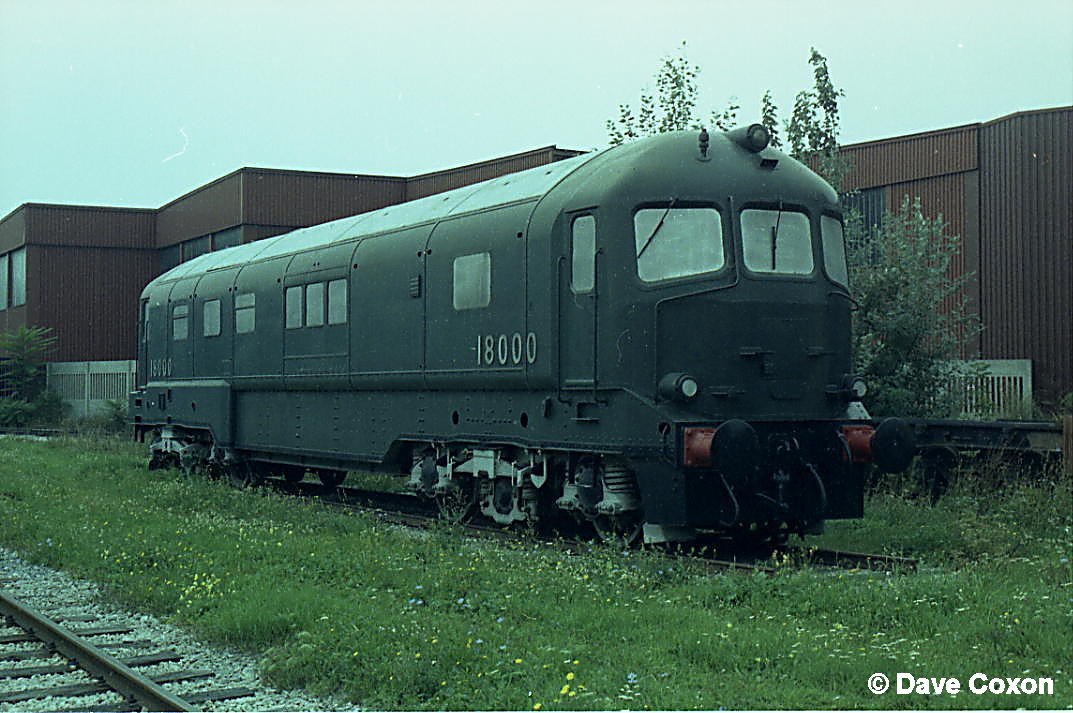- British Rail 18000
Infobox Locomotive
name = British Rail 18000
powertype = Gas Turbine-electric

caption = 18000 at Vienna in 1989
builder =Brown, Boveri & Cie and
Swiss Locomotive and Machine Works
serialnumber = BBC: 4559
SLM: 3977
builddate = 1949
primemover = Gas Turbine
poweroutput= convert|2500|hp|abbr=on|lk=on
transmission = DC generator
DC traction motors
tractionmotors=Four
tractiveeffort=convert|31500|lbf|abbr=on|lk=on
uicclass = (A1A)'(A1A)'
wheeldiameter = "Driving:" convert|4|ft|0+1/4|in|mm|0|abbr=on
"Idling:" convert|3|ft|2|in|mm|0|abbr=on
weight = convert|115.18|LT|lk=on
topspeed = convert|90|mph|km/h|0|abbr=on|lk=on
trainheating = Steam generator
powerclass = BR: 4
nicknames="Kerosene Castle"
railroad =British Railways
ordernumber = GWR Lot 372British Rail 18000 was a prototype mainline
Gas turbine-electric locomotive built forBritish Rail ways in 1949 by Brown, Boveri & Cie. It had, however, been ordered by theGreat Western Railway in 1940, but construction was delayed due toWorld War II . It spent its working life on theWestern Region of British Railways , operating express passenger services fromLondon Paddington station .Overview
The GWR chose a gas-turbine locomotive because, at the time, there was no single-unit
diesel locomotive of sufficient power available. The King classsteam locomotive could deliver about convert|2500|hp|kW at the rail. The LMS diesel locomotives had engines of only convert|1600|hp|kW|abbr=on. After allowing for transmission losses, this would be down to about convert|1300|hp|kW|abbr=on at the rail, so two diesels would be needed to match a King.No. 18000 was of A1A-A1A wheel arrangement and its
gas turbine was rated at 2,500 hp. It had a maximum speed of convert|90|mph|km/h|0 and weighed convert|115|LT|t. It was painted in BR black livery, with a silver stripe around the middle of the body and silver numbers.Technical details
The
gas turbine was a Brown Boveri industrial machine. It was of a type which would now be called aTurboshaft engine but differed from modern turboshaft engines in having only one turbine to drive both the compressor and the output shaft.The emphasis was on fuel economy so it had a heat exchanger (to recover waste heat from the exhaust) and was designed to run on cheap heavy
fuel oil . This was the same fuel that was used in oil-fired steam locomotives. After leaving the heat exchanger, the pre-heated air entered a large, vertical, combustion chamber where the fuel was injected and burned.There was also an auxiliary
diesel engine which provided power for starting the gas turbine. The diesel engine was capable of moving the locomotive at a slow speed when the gas turbine was not running. The usual procedure was to run the locomotive from the shed to Paddington station using the diesel engine and to start the gas turbine only a few minutes before the train was due to leave. This saved fuel and minimised annoyance from noise and exhaust fumes.Comparison of 18000 and 18100
The following table gives a comparison between 18000 and 18100. There are some anomalies and these are described in the notes.
Notes:
# In 18000, outputhorsepower is 24% of total horsepower and in 18100, output horsepower is 33% of total horsepower. This suggests that 18100 had the higherthermal efficiency but, in practice, 18000 had the higher thermal efficiency. The horsepower figures should, therefore, be regarded with some scepticism.
# Where electric transmission is used, the horsepower of thetraction motor s is usually 81% (i.e. 90% x 90%) that of the prime mover. The figure for 18100 is therefore about right but the figure for 18000 looks anomalous.
# lbf =pound-force Post-BR use
At the end of 1960 it was withdrawn from operation and was stored at
Swindon Works for four years. It then returned to mainland Europe, where for more than ten years it was used, in substantially altered (and no longer gas-turbine-powered) form, for experiments concerning the interaction between steel wheels and steel rails, under the auspices of theInternational Union of Railways . In 1975 it was moved toVienna and displayed outside the Mechanical Engineering Testing building.Preservation
In the early 1990s it was secured for preservation and returned to the United Kingdom; it is now kept at
The Railway Age ,Crewe .It has now been moved to Barrow Hill Roundhouse & been repainted.
ee also
*
British Rail 18100
*British Rail GT3
*British Rail APT-E ources
* Sampson, H. (editor), "The Dumpy Book of Railways of the World", published by Sampson Low, London, date circa 1960
* Robertson, K. "The Great Western Railway Gas Turbines", published by Alan Sutton, 1989, ISBN 0 86299 541 8
Wikimedia Foundation. 2010.
